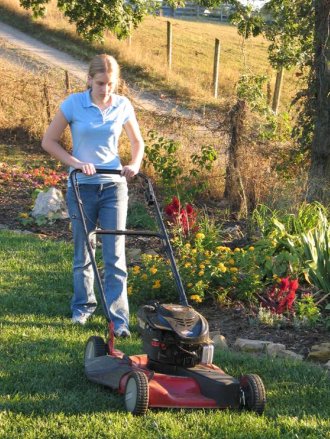Mow Like a Pro
There is nothing done more frequently in landscape maintenance than mowing the lawn, and nothing that is done with a greater frequency of mistakes either! This podcast details some of the most critical mistakes commonly made in mowing turf and how you can avoid them in your quest for a great looking, healthy lawn.

One of the unique features of turfgrasses is that unlike most other plants in the landscape our lawn grasses tolerate regular mowing at amazingly close clipping heights. There is nothing we do more frequently in landscape maintenance than mowing the lawn, and nothing we do with a greater frequency of mistakes either! Here are some tips on how you can “mow like a pro”.
Keep those blades sharp.
The quickest way to improve lawn quality AND turf health is to clip it with a sharp blade, and a sharp blade will also improve fuel-use efficiency and extend engine life. When is the last time you sharpened and balanced your mower blade? I recommend homeowners sharpen the blade at least three times per growing season: start the year off with a sharp blade (perhaps you can do this when you put the mower away for the winter?), sharpen it again in late spring, and then once more in mid-late summer.
Another way to cut grass: reel mowers.
An alternative to a rotary mower is the reel mower, a cutting unit that features a stationary bedknife and a spinning cylinder of blades. These mowers are making somewhat of a comeback in lawn maintenance as fuel prices and environmental awareness continue to increase. I see many of these units in the lawn and garden centers of many of our major discount stores each spring, usually in the $100 price range. These self-propelled units are certainly environmentally friendly because YOU provide the horsepower. These relatively cheap mowing machines work reasonably well on grasses maintained under 2 inches, but are not suitable for taller mowed turfs in the 2-3 inch range. Also, be aware that a reel mower requires specialized equipment to sharpen the cylinder of blades, a service that only specialty turf equipment stores likely provide. These mowers are ideal for relatively small, flat, and intensively maintained lawns.
Match mowing heights according to species and situation.
Most mowers have adjustments for raising and lowering the mowing height. Be sure to set your mower on a solid surface such as a driveway or sidewalk and determine what height you get from various settings. Then, set your mower’s cutting height to match the appropriate height of cut for your particular grass. If your lawn has a white hue rather than a green color after you mow, it is a good bet that you are cutting too low. While there are some differences in tolerable cutting heights between the various species of warm and cool-season turfgrasses, a general rule of thumb is to clip them in the 2-3 inch range. For cool-season turfgrasses, it is always a safer bet to begin raising their cutting heights in late spring/early summer to maximize tolerance to environmental and pest pressure. Taller cutting heights at these times help maintain the plant’s root system. On the other hand, warm-season grasses respond to mowing on the lower side of their recommended range in the summer by increasing in density. Note that shorter mowing heights will require more frequent mowing.
What about turf in the shade? Mow on the high side of the recommended range in order to maximize the plant’s leaf area. Your lawn grasses will already be at a huge competitive disadvantage to the trees in regards to light, water, and nutrients, so it needs some special attention to maintain a canopy.
Employ the “1/3rd rule” of mowing.
Perhaps you have also heard of something called the “1/3rd rule” of mowing -- that is, never remove more than 1/3rd of the leaf blade at any mowing event. Removing most of the foliage in a cutting event shocks the plant, forcing it to redirect its food resources from roots and stems towards new leaves. If the turf has gotten away from you, resist the temptation to scalp it in a single mowing event. Instead, slowly drop the mowing height every 2-3 days while returning the turf to its ideal cutting height range. This approach takes a little patience, but it will maintain plant health and prevent you from having unsightly piles of clippings that not only look bad, but can also shade and heat the turf below.
Finally, return clippings as often as possible to your turf. Clippings are nothing more than organic fertilizer for your lawn, and if you follow the 1/3rd rule, you will never produce enough clippings to cause problems with your lawn. Many rotary mowers are already outfitted with mulching attachments that chop the clippings into even finer pieces that are broken down by the soil’s microbes that much faster. You can reduce your turf’s fertility needs and help the environment by keeping your clippings in your lawn.
Need further information?
For more detailed mowing tips, open the VTTURF link on the Turf and Gardens Web page to access a BREEZE presentation entitled “Mow Like a Pro”. This Powerpoint presentation details the primary steps in mowing and mower maintenance that will improve your turf quality.
Links to Virginia Cooperative Extension publications that specifically pertain to lawn maintenance can always be found at the Virginia Cooperative Extension webpage at www.ext.vt.edu. This site contains links to all VCE publications and contact information specific to your locale. Please contact your local Virginia Cooperative Extension office if you require further assistance.
About this File
Author: Mike Goatley
Release Date: April 22, 2008
Length: 04:59
Link: Mow Like a Pro (MP3 | 2MB)
Contact Turf and Garden Tips
Please contact your local Extension office for more information related to your turf and garden questions.


